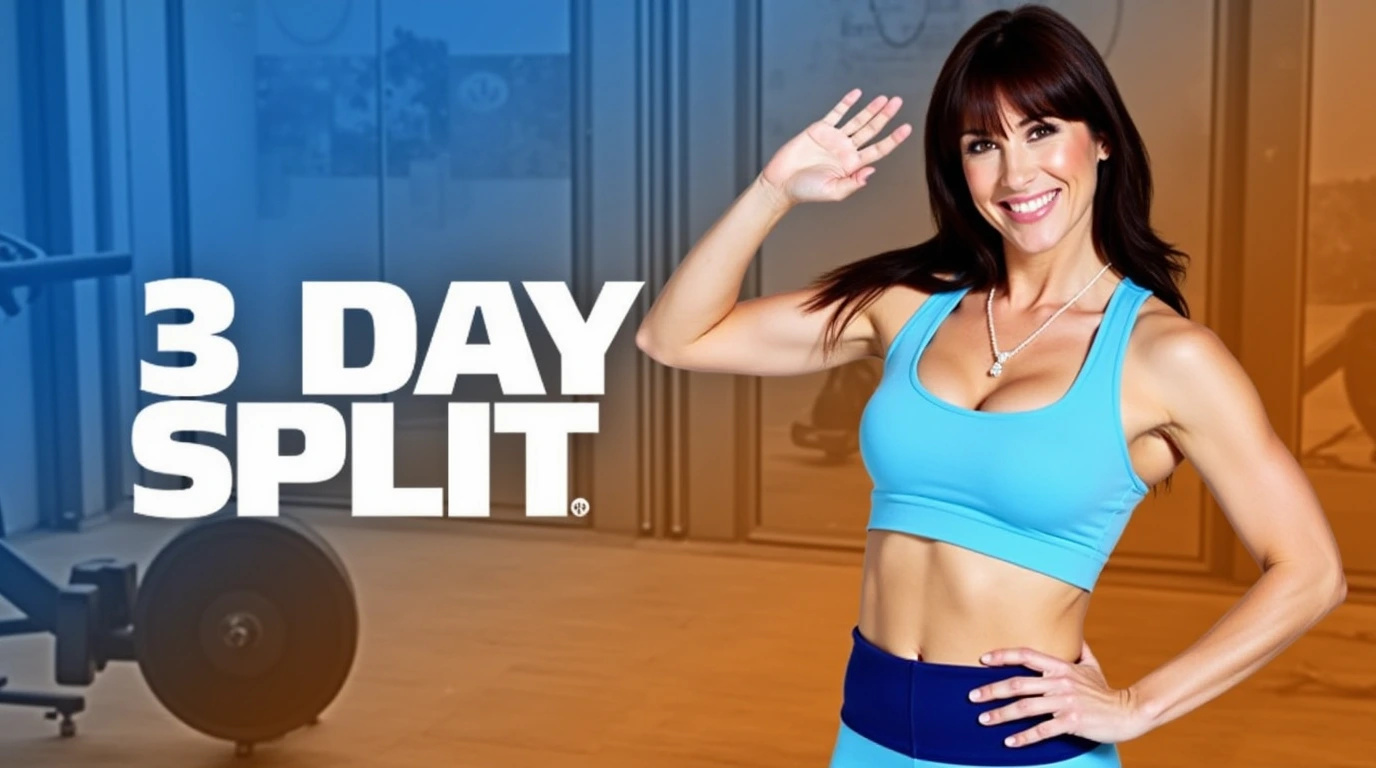The Ultimate Guide for Fitness Enthusiasts
A 3-day split workout is one of the most popular and effective ways to structure your fitness routine. If you’re looking to balance a busy lifestyle with regular exercise, this training method might be exactly what you need. But is it truly effective? Whether you’re a beginner or an experienced athlete, this guide will break down everything you need to know about the 3-day split workout, from its benefits to how you can implement it into your routine. By the end of this article, you’ll be equipped with the knowledge to decide if the 3-day split workout is the right choice for achieving your fitness goals.
Table of Contents
What is a 3-Day Workout Split?
When you’re looking for a workout routine that balances intensity with recovery, a 3-day workout split could be just the solution. Essentially, a 3-day workout split divides your exercise sessions into three distinct days per week, with each day focusing on different muscle groups or workout styles.
This type of split offers a practical solution for individuals who want to fit regular exercise into their busy lives. It’s structured in such a way that you’ll typically work out on non-consecutive days, allowing your muscles to recover between sessions. For example, you might train on Monday, Wednesday, and Friday, giving yourself two full days of rest in between.
Types of 3-Day Workout Splits
There are several variations of the 3-day split, and choosing the right one depends on your fitness level, goals, and the time you have available. Here are the most popular options:
- Push, Pull, Legs (PPL)
- Push Day: Focuses on chest, shoulders, and triceps.
- Pull Day: Targets back, biceps, and forearms.
- Leg Day: Concentrates on quads, hamstrings, glutes, and calves.
- Upper Body, Lower Body, Full Body
- Upper Body: Includes chest, back, shoulders, and arms.
- Lower Body: Focuses on the legs and glutes.
- Full Body: A comprehensive day targeting all major muscle groups.
- Body Part Split
- Day 1: Chest and back.
- Day 2: Shoulders and arms.
- Day 3: Legs and abs.
These splits offer flexibility and can be tailored to suit your specific fitness needs. Whether you’re a beginner or a seasoned gym-goer, you can find a split that works best for your goals.

The Benefits of a 3-Day Workout Split
If you’re considering a 3-day split workout routine, you might be wondering, “What’s in it for me?” Here are the top benefits that make this training approach a great option for many people:
1. Time Efficiency
We get it—life gets busy. A 3-day workout split allows you to dedicate a manageable amount of time to exercise without feeling like it’s taking over your entire week. For people with tight schedules, this setup offers the perfect balance. You can still see substantial improvements in strength, muscle tone, and endurance with just three focused workout sessions each week.
2. Muscle Recovery
Muscle recovery is crucial for progress. When you hit the gym frequently, your muscles undergo stress, which leads to microscopic tears. These tears need time to heal and grow back stronger. A 3-day split gives your muscles ample time to recover between workouts, allowing them to rebuild and grow. This means you’re reducing the risk of overtraining and burnout.
3. Flexibility
Whether you’re a beginner or experienced athlete, the 3-day workout split is incredibly versatile. You can adjust the exercises, sets, and reps according to your needs. Additionally, it gives you flexibility to fit in cardio, rest, or other activities on your off days. This makes it easier to integrate fitness into your lifestyle, no matter how busy you are.
4. Balanced Approach
The beauty of a 3-day split is that it offers a balanced approach to fitness. You can focus on strength training, cardiovascular exercises, or a combination of both. It gives you the opportunity to prioritize the muscle groups that need the most attention without overwhelming yourself. This allows for a holistic approach to fitness, addressing all aspects of your physical health.
How to Structure Your 3-Day Workout Split
The key to making your 3-day workout split effective lies in how you structure each session. Here’s a basic framework to get you started:
Push, Pull, Legs (PPL) Split
- Push Day: On this day, focus on exercises that involve pushing movements. This includes exercises for the chest, shoulders, and triceps.
- Example Exercises: Bench press, shoulder press, tricep dips, push-ups.
- Pull Day: This day is dedicated to pulling movements, targeting your back, biceps, and forearms.
- Example Exercises: Pull-ups, barbell rows, dumbbell curls, lat pulldowns.
- Leg Day: Leg day is all about building strength and endurance in the lower body, targeting your quads, hamstrings, calves, and glutes.
- Example Exercises: Squats, lunges, leg press, deadlifts, calf raises.
Upper Body, Lower Body, Full Body Split
- Upper Body Day: This day focuses on exercises that target your upper body muscles, such as your chest, back, shoulders, and arms.
- Example Exercises: Chest press, rows, bicep curls, tricep extensions.
- Lower Body Day: Dedicate this day to your legs, glutes, and lower back. This is where you’ll focus on building lower body strength and endurance.
- Example Exercises: Squats, deadlifts, lunges, leg curls.
- Full Body Day: On your full-body day, incorporate exercises that target all major muscle groups. This day can help you boost overall strength, flexibility, and cardiovascular fitness.
- Example Exercises: Burpees, squats, push-ups, kettlebell swings.
- in a table format:
| Split Type | Day | Focus | Example Exercises |
|---|---|---|---|
| Push, Pull, Legs (PPL) | Push Day | Exercises involving pushing movements, targeting chest, shoulders, and triceps | Bench press, shoulder press, tricep dips, push-ups |
| Pull Day | Exercises involving pulling movements, targeting back, biceps, and forearms | Pull-ups, barbell rows, dumbbell curls, lat pulldowns | |
| Leg Day | Building lower body strength and endurance, targeting quads, hamstrings, calves, glutes | Squats, lunges, leg press, deadlifts, calf raises | |
| Upper, Lower, Full Body | Upper Body Day | Exercises targeting upper body muscles: chest, back, shoulders, and arms | Chest press, rows, bicep curls, tricep extensions |
| Lower Body Day | Exercises for legs, glutes, and lower back, building lower body strength and endurance | Squats, deadlifts, lunges, leg curls | |
| Full Body Day | Exercises targeting all major muscle groups for overall strength and cardiovascular fitness | Burpees, squats, push-ups, kettlebell swings |

Are 3-Day Workout Splits Suitable for Beginners
If you’re new to fitness, you might wonder if a 3-day workout split is too advanced. In fact, it’s one of the best ways to get started! Here’s why:
- Gradual Progression: The 3-day split allows you to ease into a consistent workout routine without feeling overwhelmed. You can gradually increase the intensity and volume as you gain strength and confidence.
- Reduced Risk of Injury: With fewer workouts in a week, you reduce the risk of overtraining and potential injuries, which can occur when jumping into more frequent routines.
- Recovery Time: Beginners need more time for muscle recovery, which is why the 3-day split is a perfect match. Your muscles have the time they need to repair and grow stronger after each workout.
- Easy to Customize: You can tweak the exercises to match your fitness level. Whether you’re doing bodyweight exercises or using light weights, a 3-day split is adaptable.
Comparing 3-Day Workout Splits to Other Workout Routines
When considering a workout plan, it’s important to evaluate how a 3-day split compares to other training methods.
3-Day Split vs. 5-Day Split
A 5-day split involves working out more frequently, typically targeting specific muscle groups on each day. While this can lead to quicker results for advanced athletes, it might not be sustainable for everyone. A 3-day split offers a more balanced approach, giving you enough time for recovery while still delivering great results.
3-Day Split vs. Full-Body Workouts
Full-body workouts are often performed more frequently, sometimes three to five times per week. While they are great for building endurance and general fitness, they can be taxing for your body. A 3-day split allows you to dedicate more focused effort to specific muscle groups, providing a more balanced and less intense workout regimen.
What Research Says About the Effectiveness of 3-Day Workout Splits
Studies have shown that the effectiveness of a workout plan depends on a variety of factors, including the frequency of training, intensity, and recovery. Research suggests that training three times per week with sufficient rest between workouts leads to substantial improvements in strength and muscle growth. This frequency is especially beneficial for intermediate athletes and those looking to optimize muscle recovery.
One study published in the Journal of Strength and Conditioning Research found that trainees who followed a 3-day split had similar gains in muscle mass and strength compared to those who worked out more frequently. The key takeaway is that recovery is just as important as training intensity when it comes to building muscle.
Frequently Asked Questions About 3-Day Workout Splits
Q: How effective is a 3-day split for building muscle?
A: A 3-day workout split is very effective for building muscle when paired with proper nutrition and sufficient recovery. By allowing muscle groups ample time to recover, this routine promotes muscle growth and strength development over time.
Q: Can I do cardio on non-workout days?
A: Absolutely! Cardio on rest days is a great way to boost your overall fitness without hindering your muscle recovery. Just make sure you don’t overdo it—moderate cardio is ideal.
Q: How long will it take to see results with a 3-day split?
A: The timeline for results depends on your individual fitness level, diet, and consistency. Most individuals see noticeable improvements in strength and muscle tone after 4-6 weeks of consistent training.
Q: Should I add extra days if I want to improve faster?
A: While it might be tempting to add extra workout days, it’s essential to prioritize recovery. Overtraining can lead to burnout and injury. Instead, focus on increasing the intensity of your 3-day workouts to see continued progress.
Conclusion: Should You Try a 3-Day Workout Split?
If you’re looking for an effective, flexible workout routine that fits into your busy lifestyle, the 3-day workout split could be the perfect solution. Not only does it allow for focused, high-quality workouts, but it also gives your body the recovery time it needs to grow stronger. Whether you’re a beginner or an experienced fitness enthusiast, this approach offers something for everyone.
Ready to give it a try? Start with the structure that best fits your goals, stay consistent, and watch as you build strength, muscle, and endurance. With the right mindset and commitment, your fitness journey will become more manageable—and enjoyable—than ever before.

